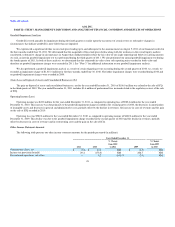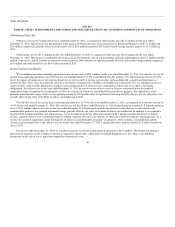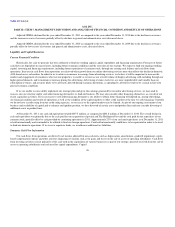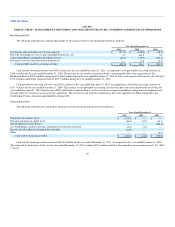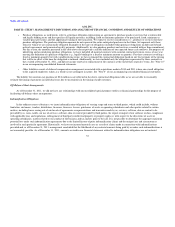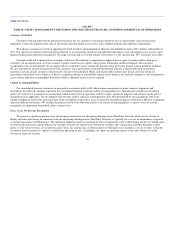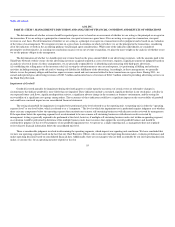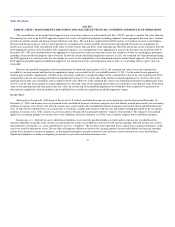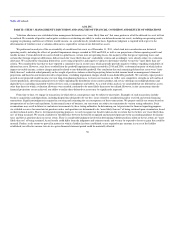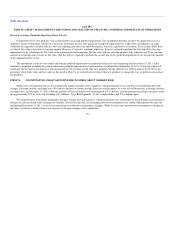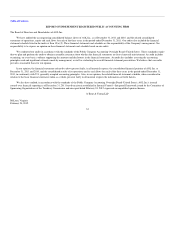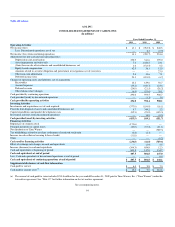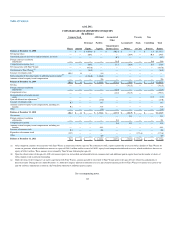America Online 2011 Annual Report Download - page 59
Download and view the complete annual report
Please find page 59 of the 2011 America Online annual report below. You can navigate through the pages in the report by either clicking on the pages listed below, or by using the keyword search tool below to find specific information within the annual report.
Table of Contents
AOL INC.
PART II—ITEM 7. MANAGEMENT'S DISCUSSION AND ANALYSIS OF FINANCIAL CONDITION AND RESULTS OF OPERATIONS
The determination of whether revenue should be reported gross or net is based on an assessment of whether we are acting as the principal or an agent in
the transaction. If we are acting as a principal in a transaction, we report revenue on a gross basis. If we are acting as an agent in a transaction, we report
revenue on a net basis. The determination of whether we are acting as a principal or an agent in a transaction involves judgment and is based on an evaluation
of the terms of an arrangement. We recognize revenue on a gross basis in situations in which we believe we are the principal in the transactions, considering
all of the indicators set forth in the accounting guidance for principal agent considerations. While none of the indicators individually are considered
presumptive or determinative, in reaching our conclusions on gross versus net revenue recognition, we place the most weight on the analysis of whether or not
we are the primary obligor in the arrangement.
The determination of whether we should report our revenue based on the gross amount billed to our advertising customers, with the amounts paid to the
Third Party Network website owner (for the advertising inventory acquired) reported as costs of revenues, requires a significant amount of judgment based on
an analysis of several factors. In these arrangements, we are generally responsible for (i) identifying and contracting with third-party advertisers,
(ii) establishing the selling prices of the inventory sold, (iii) serving the advertisements at our cost and expense, (iv) performing all billing and collection
activities including retaining credit risk and (v) bearing sole liability for fulfillment of the advertising. Accordingly, in these arrangements, we generally
believe we are the primary obligor and therefore report revenues earned and costs incurred related to these transactions on a gross basis. During 2011, we
earned and reported gross advertising revenues of $383.7 million and incurred costs of revenues of $264.7 million related to providing advertising services on
the Third Party Network.
Impairment of Goodwill
Goodwill is tested annually for impairment during the fourth quarter or earlier upon the occurrence of certain events or substantive changes in
circumstances that indicate goodwill is more likely than not impaired. These indicators include a sustained, significant decline in our stock price; a decline in
our expected future cash flows; significant disposition activity; a significant adverse change in the economic or business environment; and the testing for
recoverability of a significant asset group, among others. The occurrence of these indicators could have a significant impact on the recoverability of goodwill
and could have a material impact on our consolidated financial statements.
The testing of goodwill for impairment is required to be performed at the level referred to as the reporting unit. A reporting unit is either the "operating
segment level" or one level below, which is referred to as a "component." The level at which the impairment test is performed requires judgment as to whether
there exist any components below the operating segment that constitute one or more self-sustaining businesses with discrete results reviewed by management.
If the operations below the operating segment level are determined to be one or more self-sustaining businesses with discrete results reviewed by
management, testing is generally required to be performed at this level; however, if multiple self-sustaining business units exist within an operating segment,
an evaluation would be performed to determine if the multiple business units share resources that support the overall goodwill balance and should be
combined for purposes of this test. For purposes of our goodwill impairment test, we operate as a single reporting unit, as management does not regularly
review discrete financial information below the consolidated unit level.
There is considerable judgment involved in determining the operating segments, which impacts our reporting unit conclusion. We have concluded that
we have one operating segment based on the fact that our Chief Executive Officer, who is also our chief operating decision maker, evaluates performance and
makes operating decisions based on consolidated financial data. Additionally, there are no managers who are held accountable by our chief operating decision
maker, or anyone else, for an operating measure of profit or loss for
55


